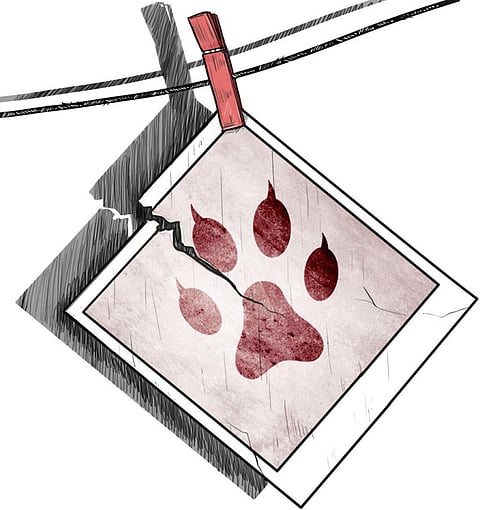

Carnivores dominate the food web. Yet, they are among the most threatened mammals in the world.
This is the reason, substantial research and conservation resources are invested towards studying, protecting and managing carnivore populations, globally.
However, this does not seem to be the case in India, despite the country being strategically important for carnivore conservation and management.
Estimates show that India is home to 23 per cent of the world’s carnivore population, belonging to 60 species.
A review of 1,792 studies published since 1947 shows that the impact of the 70 years of research on the charismatic species on their conservation status and policies in the country have been far from satisfactory.
The review, done by a team of 15 researchers from 12 Indian institutions, has further found that the wild cat family, particularly the tiger, dominates carnivore literature in the country.
The Indian leopard, golden jackal, dhole and jungle cat are the other top carnivores that have received a substantial research focus.
But the quality of studies on smaller and less charismatic carnivores has generally been poor, says the paper, published in peer-reviewed international journal Biological Conservation in 2022.
For instance, scientific research on mega-carnivore tiger has led to the establishment of Project Tiger in 1973 and helped in the establishment of tiger reserves in 50 locations across the country.
Exhaustive research has provided evidence against the construction or expansion of highways through tiger habitats in litigation, such as through Bandipur Tiger Reserve, Kanha-Pench tiger corridor and Bhagwan Mahavir Wildlife Sanctuary.
In fact, the ambitious Ken-Betwa river interlinking project, which is likely to submerge a major portion of the core area of the Panna Tiger Reserve in Madhya Pradesh, has also been contested by research data.
Similarly, research on the Indian leopard has resulted in the formulation of national guidelines on human-leopard conflict mitigation. But 76 per cent of studies on the jungle cat, one of the five most researched carnivores, are nothing but checklists and presence records.
The studies in recent decades also fail to adequately research the important link between carnivores and their ecological communities and ecosystems. This has implications for human sustenance.
For instance, previous studies have hypothesised that small cats execute an important ecological function by controlling rodent populations, known to be agricultural pests and disease carriers. Civets are known to disperse seeds and help in maintaining forest ecosystems. Recent literature lack such knowledge.
For many smaller and less charismatic carnivores like the fishing cat, which are denizens of the most threatened ecosystems on the planet—freshwaters or wetlands—even basic ecological data like distribution range remains unclarified.
As a result, wetland conservation remains under-prioritised. Grassland ecosystems, which give refuge to critically threatened species like the caracal, are also sidelined in research and conservation.
In fact, both wetlands and grasslands, despite their important ecological functions, are categorised as “wastelands” in land-use policies. The review paper has called for increased funding for research on such species, which will raise their profile and focus attention on their vulnerable and threatened habitats in India’s conservation policies.
Additionally, natural history studies, the basic stepping stone to understanding species ecology, have been dying a gradual death. This decline has been expedited by a parallel reduction in journals that publish such studies.
The review paper also cites a plethora of examples, pointing to the utter disregard of research while shaping policies that are driven by political influences and misplaced priorities.
In contravention to the directive of Supreme Court, the Gujarat government has retained its monopoly over Asiatic lion in Gir by refusing to translocate individuals to neighbouring Madhya Pradesh.
Scientific recommendations have highlighted how a single, isolated population of lions in Gir makes it highly vulnerable to extinction. The introduction of African cheetahs in Madhya Pradesh is another example of poor policy decision.
Several factions of the Indian conservation community have severely criticised this project, which has been expedited without adequate understanding of the long-term ecological viability of the project or the social carrying capacity of the introduction sites.
Frameworks, such as biodiversity heritage sites under the Indian Biological Diversity Act (2002) or community reserves under the Indian Wildlife Protection Act (1972), facilitate the maintenance of socio-ecological systems by fostering local stewardship and ultimately democratising carnivore research.
But still there is a need for access to funding opportunities and the elimination of bureaucratic hurdles to benefit non-government agencies and independent researchers. There are limited interdisciplinary studies in carnivore literature.
In a country where a rich cohort of carnivores co-occurs with densely packed human settlements, bringing an interdisciplinary lens to research will encourage socio-ecologically sensitive policies.
Such engagement needs to be collaborative and constructive by roping in communities, so that people as well as wildlife benefit from the vast local ecological knowledge.
Tiasa Adhya is co-author of the review paper, ‘‘Chasms in charismatic species Research: Seventy years of carnivore science and its implications for conservation and policy in India”, cited in the article
This was first published in the 16-31 March, 2023 print edition of Down To Earth